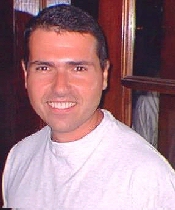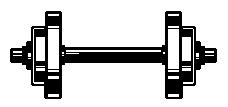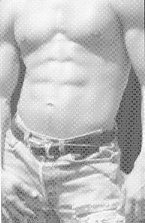THE FITNESS PAGE :)


Links to page:
* Massage
* Weight Training
* Stretching
* Abdominals
* Get a great pair of legs!!
* Cross Training
* Overtraining
* Links health & fitness sites
* Return to my home page
I am not currently working as a personal trainer but fitness is an important part of my life
and I do incorporate fitness and a healthy lifestyle into my work
If you are looking for a personal Trainer
Check out Derek Motsinger at Full Circle Fitness Coaching
Tell Derek I sent you!!
 <----- E-mail me
<----- E-mail me
MASSAGE & WORKING OUT
Massage has been around to help athletes since ealy civilization. The Greeks used massage in the Olympic Games to keep
their athletics in top conditions. The Romans athletes and gladiators also used massage to keep in top form. Shouldn't you too?
Exercise can place a tremendous stress on the body. Intense training can bring about fatigue and decrease the effectiveness
of the exercise. Much stress is placed on the tendons and ligaments, possibly stretching them to excess and tearing muscle fibers.
Fluid accumulates in those areas creating soreness and stiffness. The impact of repetitive movements and muscle strain take a cumulative toll on the
body's connective tussue (muscles, tendons & ligaments).
Fitness buffs and athletes who are interested in peak performance use massage therapy to help enhance their over-all performance.
Massage helps to stimulate circulation and loosen the muscel fibers that are bound together. This also enhances lymph circulation,
lubrication of the muscles, reducing friction and helps to remove toxins and acids.
Massage helps you to:
- maintain your entire body in the better physical condition
- reduce risk of injuries and loss of mybility (range of motion)
- boost your performance and endurance
- reduce muslce soreness
- reduce muscle tightness and restriction, improving tone, flexibility and relaxation
You do not have to wait for the painful stresses and strains of overused muscles to come in for a massage. maintenance
massage is a good idea on a regular basis. Ideally it would be weekly. Therefore treat yourself to a massage as often as
possible. Be good to yourself and your body
Back to Top Of Page
Weight Training

- Weight Training
- is an activity that can be done in a short period, yet it makes dramatic changes in how your
body looks and feels. Many who weight train would tell you that having a firm body not only
feels great---- it also positively affects how you relate to others, increases your energy level,
and improves our productivity at all activities.
-
- Weight training helps to maintain muscle strength, musclear endurance, neuromuscular (nerve-muscle)
coordination, and bone density (helping to avoid osteoporosis). The latest research suggests that
weight training makes a significant contribution to quality of life, whatever one's age or gender.
(from Fitness Weight Training Baechle & Earle 1995 Human Kinetics)
Excellent Source.
Back to Top Of Page
Stretching
- Stretching Tips
- One of the best things you can do for yourself is to stretch that muscle group after each set.
Then stretch again after you are finished with your workout. Stretching like this will help prevent
scar tissue building up within the muscle tissue (cells).
Stretching lengthens the muscle so remember to stretch slowly and keep breathing........ only stretch
as far as you can comfortablly go. Never over stretch and don't bounce, just hold the stretch.
- Move slowly into the stretch position, stretching to a point where you can feel tension, not pain!!!
- Relax, breathe in deeply, then exhale
- Hold the stretch (not your breath) for 10 or more seconds, then return slowly to the original position
- Perform each stretch at least twice
Stretching and Flexablity
Back to Top Of Page
Abdominals

- WARNING !!!!!!! WARNING !!!!!!!
- Abdominal exercises will not reduce fat around your midsection.
They will
however tone and build the abdominal muscles. Use weight training, aerobics and good nutrition
to reduce your body fat and use abdominal exercised to tone the abdominal muscles. This
combination will help you to attain your goal of a good looking and healthy midsection.
- Muscles involved:
- Rectus abdominis, interanl, external obliques and transversus abdominis(although
this muscle is not involved in moving the spine it is important to mention this deep muscle.
This muscle plays an important role in forced expiration.).
- Movment of the Spine
-
- Flexion, or forward bending of the spine
- Extension, or the return from flexion
- Lateral flexion, or bending sideways to the right or left
- Shoulder rotation, a twisting action around the axis of the spinal column
- Things to consider when doing abdominal training:
-
- Be careful of what you eat, if you tend to put on fat in the midsection.
- Include some type of aerobic activity in your workout program, this will keep your metabolism up
- Maintain good posture while sitting and standing, soon it will become second nature
- Perform a variety of exercises for the abdominals every other day
Back to Top Of Page
Get a great pair of legs!!
 Our legs, one of the most neglected body parts when training, need to be exercised. They balance our bodies, hold us
up and keep us upright. The whole leg needs to be worked out, not just the front or the back but all of the leg muscles.
The calf, quadriceps, hamstrings, hips and inner and outer thighs. Yes the legs are not easy to train, but donít forget they do
a lot of work for us already. We use our legs all the time.... from the moment we get up in the morning to the time we get back
in bed at night. So be good to your legs and exercise them.
Our legs, one of the most neglected body parts when training, need to be exercised. They balance our bodies, hold us
up and keep us upright. The whole leg needs to be worked out, not just the front or the back but all of the leg muscles.
The calf, quadriceps, hamstrings, hips and inner and outer thighs. Yes the legs are not easy to train, but donít forget they do
a lot of work for us already. We use our legs all the time.... from the moment we get up in the morning to the time we get back
in bed at night. So be good to your legs and exercise them.
The calf is made up of 2 muscles, gastrocnemius and soleus muscles. The gastrocnemius is located closes to the surface.
The soleus is under the gastrocnemius. The action of these muscles are plantar flexion or heel raises (the gastrocnemius is also
involved in leg flexion). Heel raises or calf raises is the exercise to do for this muscle group. The standing calf raise exercises
both muscles but the seated calf raise only works the soleus. When doing these exercise go through a full range of motion to
work the muscle fully.
The quadriceps is made up of 4 muscles, the rectus femoris, vastus lateralis, vastus medialis and vastus intermedius.
All four muscles combine into one tendon and attaches into to patella bone. These muscle all work to extend the knee. The
3 vastus muscles all originate on the femur. The rectus femoris
originates on the pelvic girdle making it work at the hip as well as the knee joint. Some exercises for the quadriceps muscle
group are the leg extension, squat, leg press and lung. The leg extension is the only exercise that isolates the quadriceps.
The other exercises are all compound exercise and use other muscle groups as well.
The hamstring is made up of 3 muscles, the biceps femoris, semitendinosus and semimembranosus. This muscle group
acts on 2 joints, at the knee and the hip joint. These actions are stronger when done separately, then when both joints are
moving at the same time. Some exercise for the hamstring are the leg curl, squat, leg press and the back raise.
Donít work the quadriceps more then the hamstring muscles. They need to be in balance. It is important to work
both muscle groups sufficiently. When these muscles are not in balance problems with your back may start to happen.
The muscles that make up the hip flexors are the rectus femoris, psoas major, iliacus and pectineus muscles.
The muscles that make up the hip extensors are the hamstrings and gluteus maximus muscles. The exercises for these
muscles groups are hip flexion and hip extension. These exercises can be done using cables. When the hip flexors and the
hip extensor muscles are strong and flexible, the pelvis will be properly positioned to balance the spine effectively.
The muscles that make up the inside of the hip or hip adductor are the adductor longus, brevis and magnus and the
gracilis muscles. These are some of the largest muscles in the body. These muscles are strong to create a stable internal base
for the pelvis and also to aid in rotation of the hip. One of the best exercise for this group is hip adduction ( bringing the legs
together, towards the midline of the body ). Since these are very strong muscles it is recommended to do higher repetitions.
The muscles on the outside of hip or hip abductor muscles are the gluteus medius, gluteus minimus and the
tensor fasciae latae. This muscle group is important because it is used for lateral movement. The gluteus medius is the
main muscle involved in holding the pelvis level while you are running. An exercise for this group is hip abduction
(spread the legs apart, away from the midline of the body).
Back to Top Of Page

Cross Training
Benefits of cross training
- Reduced risk of injury. By spreading the cumulative level of orthopedic stress over additional muscles and joints,
individuals are able to exercise more frequently and for longer durations without excessively over loading particularly vulnerable
areas of the body (e.g. knees, hips, back, shoulders, elbows and feet).
- Enhanced weight loss. Individuals who want to lose weight and body fat should engage in an exercise program
that enables them to safely burn a significant number of calories. Research has shown that such a goal, in most instances, is
best accomplished when individuals exercise for relatively long durations (e.g. more than 30 minutes) at a moderate level of
intensity (e.g. 60 to 80 percent of maximal heart rate).
- Improve total fitness. Cross training can include activities that develop muscular fitness, as well as aerobic
conditioning. While an individual's muscular fitness gain will typically be less than if he participated only in strength training, the
added benefits of improving muscular strength and endurance can pay substantial dividends.
- Enhanced exercise adherence. Research on exercise adherence indicates that many individuals drop out of exercies
programs because they become bored or unmotivated. Cross training is a safe and relatively easy way to add variety to an exercise
program. In the process, cross training can help play a positive role in promoting long-term exercise adherence by eliminating or
diminishing the onset of boredom
- Guidelines for Cross Training You can choose to vary your exercise programs from workout to workout by
engaging in different types of activities or you can simply add a new form of exercies to you current workout program. One
of the easiest ways to inorporate cross training is to alternate between activities from day to day (e.g. run one day, weight
train the next, cycle the next, ect.).
source: Cross training: the heart of the matter (Aug 96)
Back to Top Of Page
OVERTRAINING
Some of the factors in overtraining:
1 Too much eccentric exercise stress on your body
2 Poor coaching
3 Drugs
4 Time consuming/strenuous job that interferes w/ workouts
5 Poor diets and/or sleep habits
6 Monotony in training or lifestyle
Ways to avoid overtraining:
1 Develop a schedule that doesnít stress you
2 Develop a rational training program
3 Vary your training methods
4 Get plenty of sleep and rest, if needed take naps
5 Eat plenty of good food & drink lots of water
6 Get a massage -----> go to my Massage Therapy Page
Back to Top Of Page

YMCA of San Diego
American Bodybuilding
Men's Fitness
Muscle & Fitness
Back to Top Of Page
 Return to my home page
Return to my home page
Jerry's Fitness Page
Last updated April 2008



 <----- E-mail me
<----- E-mail me 

 Our legs, one of the most neglected body parts when training, need to be exercised. They balance our bodies, hold us
up and keep us upright. The whole leg needs to be worked out, not just the front or the back but all of the leg muscles.
The calf, quadriceps, hamstrings, hips and inner and outer thighs. Yes the legs are not easy to train, but donít forget they do
a lot of work for us already. We use our legs all the time.... from the moment we get up in the morning to the time we get back
in bed at night. So be good to your legs and exercise them.
Our legs, one of the most neglected body parts when training, need to be exercised. They balance our bodies, hold us
up and keep us upright. The whole leg needs to be worked out, not just the front or the back but all of the leg muscles.
The calf, quadriceps, hamstrings, hips and inner and outer thighs. Yes the legs are not easy to train, but donít forget they do
a lot of work for us already. We use our legs all the time.... from the moment we get up in the morning to the time we get back
in bed at night. So be good to your legs and exercise them.

 Return to my home page
Return to my home page
